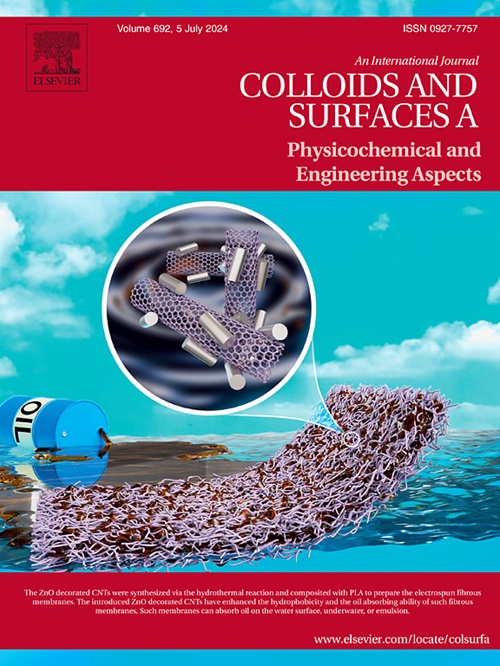Magnetically controlled nanoparticles for paclitaxel release from polymer encapsulated iron oxide nanoparticles fabricated via flash nanoprecipitation
IF 4.9
2区 化学
Q2 CHEMISTRY, PHYSICAL
Colloids and Surfaces A: Physicochemical and Engineering Aspects
Pub Date : 2025-05-16
DOI:10.1016/j.colsurfa.2025.137106
引用次数: 0
Abstract
Magnetically controlled drug release, combining superparamagnetic iron oxide nanoparticles (IONPs), biocompatible polymers and therapeutic drugs, offers a promising alternative to conventional cancer therapies, enhancing efficacy while minimizing side effects. One approach for encapsulating organic and inorganic moieties in polymers is by using flash nanoprecipitation (FNP), a method known for its robustness and scalability.
In this study, IONPs were synthesized via co-precipitation, followed by oleic acid coating to impart hydrophobicity, resulting in dry sizes of 9 ± 2 nm. These oleic acid coated IONPs (OA-IONPs) were encapsulated in poly(lactic-co-glycolic acid) (PLGA) using FNP, following operational conditions used for bare polymeric nanoparticles (PNPs). For a defined set of operational variables, it was observed that increasing the theoretical concentration of IONPs in the solvent stream from 0.11 wt% to 0.34 wt% resulted in enhancement of IONPs encapsulation efficiency. The FNP process was further modified to encapsulate a hydrophobic anti-cancer drug, paclitaxel and the co-encapsulation of IONPs and the drug was confirmed through various characterization techniques, including electron microscopy, energy dispersive X-ray and Fourier Transform Infrared spectroscopies. Magnetically controlled drug release was investigated using an alternating magnetic field, revealing that drug release was at least four times higher than the case where the magnetic field was absent. These findings along with biocompatibility studies showcase potential of such magnetically controlled drug release nanocarriers in cancer therapeutics.
磁控纳米粒子释放紫杉醇从聚合物封装的氧化铁纳米粒子制备的闪速纳米沉淀法
磁控药物释放,结合超顺磁性氧化铁纳米颗粒(IONPs),生物相容性聚合物和治疗药物,提供了一种有希望的替代传统癌症治疗方法,提高疗效,同时最大限度地减少副作用。在聚合物中封装有机和无机部分的一种方法是使用闪光纳米沉淀(FNP),这种方法以其稳健性和可扩展性而闻名。本研究采用共沉淀法合成离子粒子,然后用油酸包覆以增强其疏水性,得到的离子粒子干尺寸为9±2 nm。按照裸聚合物纳米颗粒(PNPs)的操作条件,使用FNP将这些油酸包被的IONPs (OA-IONPs)包裹在聚乳酸-羟基乙酸(PLGA)中。对于一组定义的操作变量,观察到溶剂流中IONPs的理论浓度从0.11 wt%增加到0.34 wt%,导致IONPs封装效率提高。进一步改进FNP工艺,包封疏水性抗癌药物紫杉醇和离子离子束的共包封,并通过各种表征技术,包括电子显微镜,能量色散x射线和傅里叶变换红外光谱来证实药物。使用交变磁场研究磁控药物释放,发现药物释放至少比没有磁场的情况高四倍。这些发现以及生物相容性研究显示了这种磁控药物释放纳米载体在癌症治疗中的潜力。
本文章由计算机程序翻译,如有差异,请以英文原文为准。
求助全文
约1分钟内获得全文
求助全文
来源期刊
CiteScore
8.70
自引率
9.60%
发文量
2421
审稿时长
56 days
期刊介绍:
Colloids and Surfaces A: Physicochemical and Engineering Aspects is an international journal devoted to the science underlying applications of colloids and interfacial phenomena.
The journal aims at publishing high quality research papers featuring new materials or new insights into the role of colloid and interface science in (for example) food, energy, minerals processing, pharmaceuticals or the environment.

 求助内容:
求助内容: 应助结果提醒方式:
应助结果提醒方式:


